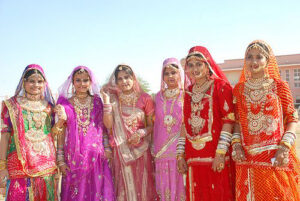
Introduction:
In the vibrant tapestry of Indian culture, Makar Sankranti and Lohri stand out as two joyous festivals that mark the transition of winter to spring. Rajasthan, known for its rich heritage and traditions, comes alive during these celebrations, and what adds a unique and empowering touch to the festivities is the active participation of women. In this feature article, we delve into the heart of Rajasthan to explore how women play a central role in the exuberant celebration of Makar Sankranti and Lohri.

Makar Sankranti: A Festival of Sun and Harvest:
Makar Sankranti, celebrated on January 14th, signifies the entry of the sun into the zodiac sign of Capricorn. In Rajasthan, this festival is synonymous with colorful kites adorning the sky, symbolic of the triumph of light over darkness. Women in Rajasthan contribute significantly to the preparations and festivities, infusing their unique energy into the celebrations.

Preparing for the Skies:
The days leading up to Makar Sankranti witness women engaging in meticulous preparations. From stitching vibrant kites to selecting the perfect strings, women in Rajasthan actively participate in the age-old tradition of kite-flying. The markets buzz with their vibrant presence as they negotiate for the best materials, showcasing their negotiation skills.

Culinary Delights:
Food plays a crucial role in any Indian celebration, and Makar Sankranti is no exception. Women take charge of the kitchen, preparing a plethora of traditional delicacies like til ladoo, gajak, and feasts featuring dishes made from newly harvested crops. The aroma of these delights wafts through the air, adding to the festive ambiance.
Colorful Attire:
The women of Rajasthan, known for their exquisite taste in traditional attire, don vibrant and colorful clothes during Makar Sankranti. Traditional ghagra-cholis and odhnis, adorned with intricate mirror work and embroidery, create a visual spectacle, turning the celebration into a riot of colors.
Lohri: A Bonfire of Unity and Prosperity:
As the people of Punjab celebrate Lohri with bonfires, dance, and song, Rajasthan, too, embraces this festival with fervor. Women contribute significantly to the vibrant spirit of Lohri, showcasing their strength, resilience, and community bonds.
Collective Celebrations:
Lohri is a community celebration where families and neighbors come together around a bonfire. Women, in particular, play a vital role in organizing and participating in these gatherings. From singing traditional Lohri songs to performing folk dances, they add an authentic touch to the festivities.
Rituals and Traditions:
Women lead in performing the customary rituals associated with Lohri, such as offering sesame seeds, jaggery, and popcorn to the sacred fire. The warmth of the bonfire mirrors the unity and harmony among the women, symbolizing their collective strength in facing challenges.
Empowering the Next Generation:
Makar Sankranti and Lohri are also occasions for passing down traditions to the younger generation. Women take on the role of storytellers, sharing the significance and stories behind these festivals, ensuring the cultural legacy lives on.
Craftsmanship and Creativity:
Apart from actively participating in the rituals, women showcase their artistic skills through intricate rangoli designs. The vibrant patterns drawn at the entrance of homes symbolize prosperity and serve as a warm welcome to guests.
Challenges and Triumphs:
Despite the enthusiasm and vigor with which women participate in Makar Sankranti and Lohri celebrations in Rajasthan, they face certain challenges. The patriarchal structure of society can sometimes limit their active involvement. However, many women are breaking these barriers and emerging as leaders, steering the festivities towards a more inclusive and empowering direction.
Empowering Initiatives:
Several initiatives and organizations in Rajasthan are working towards empowering women during these festivals. Skill development workshops for kite making, cooking competitions, and cultural events provide platforms for women to showcase their talents and foster a sense of community.
Educational Outreach:
To address gender disparities, educational programs are being conducted to raise awareness about the importance of empowering women. These programs emphasize the significance of equal participation in festivals, promoting a more inclusive and progressive society.
Conclusion:
The celebration of Makar Sankranti and Lohri in Rajasthan is not merely a festival; it’s a reflection of the vibrant spirit, resilience, and unity of its women. Through their active involvement in various aspects of the festivities, women are not just preserving cultural traditions but also breaking societal barriers. As the kites soar high and the bonfires blaze, the women of Rajasthan stand as beacons of empowerment, illuminating the festivals with their strength, creativity, and indomitable spirit. Makar Sankranti and Lohri, celebrated with the radiant presence of these women, become more than traditions; they become a testament to the evolving narrative of empowerment and inclusivity in the heart of India.